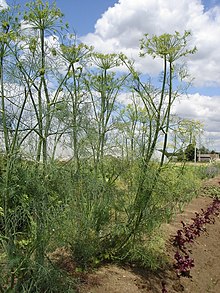Dillapiol
| Structural formula | |||||||||||||||||||
|---|---|---|---|---|---|---|---|---|---|---|---|---|---|---|---|---|---|---|---|

|
|||||||||||||||||||
| General | |||||||||||||||||||
| Surname | Dillapiol | ||||||||||||||||||
| other names |
|
||||||||||||||||||
| Molecular formula | C 12 H 14 O 4 | ||||||||||||||||||
| Brief description |
yellow-green color |
||||||||||||||||||
| External identifiers / databases | |||||||||||||||||||
|
|||||||||||||||||||
| properties | |||||||||||||||||||
| Molar mass | 222.24 g · mol -1 | ||||||||||||||||||
| Physical state |
firmly |
||||||||||||||||||
| density |
1.16 g cm −3 |
||||||||||||||||||
| Melting point |
29.5 ° C |
||||||||||||||||||
| boiling point |
285 ° C |
||||||||||||||||||
| safety instructions | |||||||||||||||||||
|
|||||||||||||||||||
| Toxicological data | |||||||||||||||||||
| As far as possible and customary, SI units are used. Unless otherwise noted, the data given apply to standard conditions . | |||||||||||||||||||
Dillapiol is a natural product from the group of phenylpropanoids .
Occurrence
It is found in essential oils and the like. a. in fennel and dill and is an isomer of apiol . It is obtained by isolating it from the Brazilian medicinal plant Heckeria umbellata ( Piperaceae ).
Individual evidence
- ↑ a b c d Dillapiole data sheet at Sigma-Aldrich , accessed on October 16, 2016 ( PDF ).
- ↑ a b c Entry on dillapiol in the ChemIDplus database of the United States National Library of Medicine (NLM) .
- ↑ Entry on Dill-Apiol. In: Römpp Online . Georg Thieme Verlag, accessed on March 13, 2013.
literature
- Shulgin, Alexander (1967): Psychotropic Phenylisopropylamines derived from Apiole and Dillapiole. In: Nature . Vol. 215, pp. 1494-1495. PMID 4861200 HTML

